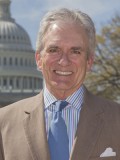 Let me begin this retrospective on the 19-year court tenure of Justice David Souter by returning to an earlier prognostication. In November 1990, after Justice Souter’s confirmation and on the eve of his service on the U.S. Supreme Court, I wrote the following in Report from the Capital:
Let me begin this retrospective on the 19-year court tenure of Justice David Souter by returning to an earlier prognostication. In November 1990, after Justice Souter’s confirmation and on the eve of his service on the U.S. Supreme Court, I wrote the following in Report from the Capital:
Judge Souter’s position on First Amendment issues becomes critically important as this new, conservative-leaning, philosophically-statist Court moves into the 1990’s. We cannot expect Judge Souter to fill William Brennan’s strong leadership role in church-state cases, at least not immediately. However, one hopes that Judge Souter’s voting record will be as good as Brennan’s and that in time he will be able to steer the Court in the direction that will restore our ‘first liberty’ to the constitutional pre-eminence that it deserves.
As one whose predictions are often wrong, I think I can boast some reasonable accuracy in this one about Justice Souter’s church-state record. Of course, how Justice Souter would perform on the Court was not entirely clear at the time of his nomination. His tenure as a justice on the New Hampshire Supreme Court and brief service on a Federal appeals court revealed only a meager record on church and state. However, his Senate Judiciary Committee hearing incorporated promising testimony about his understanding of the First Amendment’s religion clauses and how he would interpret them on the High Court. . . . .
Although it is debatable whether Justice Souter ever matched the stature of Justice Brennan (who served 34 years) in his political savvy and ability to cobble together five-vote judicial majorities, Justice Souter’s church-state jurisprudence on the merits proved to be on target and very close to what the Baptist Joint Committee argued before the Court in the 20 church-state cases in which he participated.
Space does not permit a full-scale analysis of the corpus of Justice Souter’s work, even when limited to church and state. However, his opinions in two early cases sketched out his thinking about both the Establishment Clause and the Free Exercise Clause in a way that anticipated and informed his decision making throughout the remainder of his tenure on the Court.
During Justice Souter’s second term, the Court decided Lee v. Weisman, 505 U.S. 577 (1992), the Rhode Island middle school graduation prayer case. The Court ruled that prayer delivered by a Jewish rabbi at the school-sponsored graduation ceremony violated the Establishment Clause. Justice Anthony Kennedy wrote the majority opinion for a divided Court, and Justice Souter offered a concurring opinion in which Justice John Paul Stevens and Justice Sandra Day O’Connor joined.
Although agreeing with the Court’s opinion, Justice Souter wrote separately to make clear his understanding that the Establishment Clause bars favoring religion over irreligion, not just promoting one particular religion over others. Similarly, he opined that actual coercion of religious practice was not a necessary element of an Establishment Clause violation, and that a general endorsement of religion by government would be sufficient. In unpacking his understanding of the Establishment Clause, Justice Souter appealed to the language of the amendment itself, Court precedent and his perception of the intent of the framers, particularly James Madison.
Justice Souter went on to warn that his embrace of a robust Establishment Clause should not be read to indicate a lack of appreciation for a strong Free Exercise Clause. Thus, he was careful to point out that, just because “government must remain neutral in matters of religion does not foreclose it from ever taking religion into account. The state may ‘accommodate’ the free exercise of religion by relieving people from generally applicable rules that interfere with their religious callings.”
The next term, in the Church of the Lukumi Babalui Aye v. City of Hialeah, 508 U.S. 520 (1993), Justice Souter set forth, in a more complete fashion, his understanding of the Free Exercise Clause. In Lukumi, the Court ruled unanimously, again with Justice Kennedy writing the opinion, that a governmental targeting of religion for discriminatory treatment — a religion-specific ban on animal sacrifice — violated the First Amendment’s Free Exercise Clause. Justice Souter filed a concurring opinion that criticized a case decided by the Court three years earlier in Employment Division v. Smith. There, a narrow Court majority essentially gutted the Free Exercise Clause by ruling that it did not protect against generally applicable, facially neutral laws that indirectly burden the exercise of religion. Justice Souter’s respect for Court precedent and his disinclination to decide a case more broadly than is needed caused him to refrain from seeking to overrule Smith in Lukumi. But he specifically called for a “reexamining of the Smith rule in the next case that would turn upon its application.” Unfortunately for the sake of religious liberty, that occasion never presented itself.
The BJC applauded Justice Souter’s analysis in both of these cases and in nearly every other opinion in the church-state field that he wrote. The only case in which the position of the BJC and the opinion of Justice Souter differed was Good News Club v. Milford Central School, 533 U.S. 98 (2001). There we supported the Court’s ruling that an adult-led, after school religious club meeting in an elementary school classroom did not violate the Establishment Clause. Justice Souter dissented saying that the precedent relied on by the Court majority, Lamb’s Chapel v. Center Moriches Union Free School District (1993), did not apply. He reasoned that Lamb’s Chapel simply approved the use of school property on weekends to present a variety of views about family issues, including from a religious standpoint, whereas in Good News it was “beyond question that Good News [Club] intends to use the public school premises not for the mere discussion of a subject from a particular, Christian point of view, but for an evangelical service of worship calling children to commitment themselves in an act of Christian conversion.” Moreover, in further keeping with Justice Souter’s nuanced approach to judging, he would have remanded the case to a lower court to further develop the record before he would be comfortable deciding the Free Speech Clause and Establishment Clause issues in the case.
All of this is to say Justice Souter will be difficult to replace when it comes to church and state. More than any other justice, he has reflected the BJC’s understanding of the proper interpretation of the religion clauses and how they apply to contemporary church-state issues. During his tenure, he has been an intellectual force arguing for a muscular understanding of the two clauses, but applying them in a way that respects precedent and judicial restraint. His careful, incremental and measured style in deciding cases is similar to that of Justice O’Connor — although his religion clauses jurisprudence was more predictable and genial to church-state separation. The best that we can hope for from Justice Souter’s successor is for him or her to be a thoughtful, fair-minded, hard working jurist. After all, that is what Justice Souter has been for nearly two decades.
We shall miss him.




